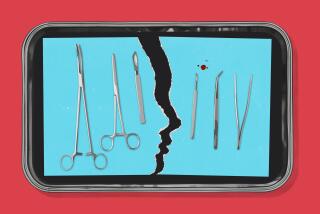A Rare Man Practices the Art and Science of Reconstructive Surgery
- Share via
The patient’s family wasn’t ready for the man they saw. He was tall, had the girth of the Harvard football player he once was and seemed self-assured.
Dr. Pearlman Hicks looked at the patient in the emergency room and thought, “Oh, please, I really don’t want to take care of this guy”--the man had the words Ku Klux Klan , accompanied by a Confederate flag, tattooed on his stomach.
The man’s family looked at the black plastic surgeon nervously.
“ ‘Ah, you sure you want to do this?’ ” Hicks remembered them asking. The man had severely injured his hand.
Family Questioned Everything
“I took care of it,” said Hicks, a surgical resident at the time, “but he was very concerned and the family questioned everything I did: ‘Isn’t that too long to leave in the stitches? Shouldn’t you do this? Shouldn’t you do that?’ But the guy did very well.
“Later on he came in to see me and said, ‘You know, I was really embarrassed when you came in and I had these tattoos on. I had them put on when I was a kid. I’d like you to take them off for me.’ ”
Hicks took them off.
“Of course, that was after several months of him being my patient. He realized that I didn’t treat him any differently because he had a KKK tattoo, and he wasn’t treating me any differently because I was black,” Hicks said. “Most people, if you treat them OK, they’ll treat you OK. But some people, you just don’t know. There are some bad apples out there. I get my share of them, too.”
Hicks is a rare man in a rare specialty. Among the 552,716 practicing physicians in the United States, only about 3,000 are plastic and reconstructive surgeons, according to the Chicago-based American Society of Plastic Surgeons.
And of the approximately 14,000 black doctors in the country, only 37 are in the field of plastic and reconstructive surgery, according to the National Medical Assn., the American Medical Assn.’s black counterpart. And only seven of those blacks have been certified by the American Board of Plastic Surgery.
When he came to California in 1979, the Harvard-educated Hicks became the first board-certified black plastic surgeon in the state. Now, there are four. One is his partner, Dwight L. Roberson, and the two others are in the San Francisco area.
As with neurosurgeons, there isn’t a need for hundreds of thousands of plastic surgeons, physicians say. There are enough to serve the country’s needs. But, also as with neurosurgery, plastic surgery requires one of the longest training periods in medicine--seven years of residency, compared with three to five for most other specialties. The time and expense discourage many doctors from entering the field.
Blacks are even slower to enter this specialty because so few have been exposed to it, said Iven LeFlore, who in 1976 became the second black in the nation to be certified as a plastic surgeon.
Black Schools Don’t Teach It
The District of Columbia physician explained that the country’s two major black medical schools--Howard University and Meharry Medical School--have no plastic surgery programs. These historically black schools have produced most of the nation’s black physicians.
“So if the two major schools don’t have it, blacks are not going to have much exposure to (the field),” he said. “I’m fairly sure that’s why blacks are so slow to get started in this area.”
Hicks, 40, was elected head of the department of plastic surgery at Long Beach Memorial Hospital last month and has a private practice with offices in Beverly Hills, Long Beach and Inglewood. He always wanted to be a doctor and knew early in his training that he wanted to be surgeon. A sports injury paved the way for the kind of surgeon he would become.
“I used to play football at Harvard, but I broke my ankle the last year and didn’t play,” Hicks said. “I got a job at Massachusetts General Hospital in Boston, and I worked in the laboratory with some ear, nose and throat doctors who were doing surgery on animals.”
Stumbled Onto Literature
He learned a little about surgery and research in the process and immersed himself in medical literature. By chance, much of what he read “happened to be about plastic surgery of the head and neck.”
After he graduated from Harvard in 1968, Hicks went on to medical school at Case Western Reserve University in Cleveland and immediately sought out the school’s plastic surgeons.
“I would go and watch them do operations and meet them in the emergency room. . . . They were technically very skillful and did a lot of very delicate work. I was fascinated.”
After medical school, he put in five years as a general surgical resident at Case Western’s University Hospitals and was made chief surgical resident there from 1976 to 1977. Then he went back to Massachusetts and completed two years of plastic surgery residency at Harvard University; in his last year there, he was chief resident in plastic surgery at Boston Childrens Hospital and the Peter Bent Brigham Hospital.
Hicks said most plastic surgeons only make it through the long years of training with the financial help of their families.
On His Own Financially
“But I wasn’t married and my folks didn’t have any money.” His mother is a housewife, his father owns a dry cleaning business and there were four other children.
How did he get through it? Moonlighting. He would work from 6 a.m. to 6 p.m. at the hospital where he did his residency, then go to another hospital and work in the emergency room all night. It was a 24-hour workday.
And the competition was tough.
“At that time, there were only about 2,500 plastic surgeons in the whole country, and there was a lot of competition for (jobs). And most of them, let’s face it, would go to Caucasians. I’m not saying it was all due to racism, but that was part of it.”
He would interview some places and people would sputter: “ ‘Well, well, we never heard of a black plastic surgeon before. We’ve, we’ve just never heard of it.’ And one place told me I’d be the first black doctor ever to work in the hospital.” That was in Cincinnati. “As a matter of fact the chief (of staff) said to me, ‘You’ll be breaking ground.’ ”
Some Reservations
He recalled what he muttered then: “I don’t think I wanna break ground in Cincinnati.”
Hicks’ impressive academic credentials and professional success suggest a relentless pursuit of excellence. A colleague at Long Beach Memorial Hospital, Dr. Myron Bloom, described him as a man with a “quiet, concerned manner. I wouldn’t call him real outgoing, but not shy and inhibited by any means.”
Married now and the father of two boys, Hicks sat in his Long Beach office one evening before he had to go into surgery and talked softly about himself and his work. He displayed the easy, self-assured manner of a man who had come far but had not forgotten where he started. The desk that separated him from a visitor might just as well have been the kitchen table in his parents’ house in Hamilton, Ohio, a farm town about 20 miles from Cincinnati.
“His hand was badly smashed and fractured and all the skin was torn off the top of it,” he said of a boy who was run over by a truck.
A Success Story
The hand was so badly damaged other doctors were saying “ ‘You’re going to have to amputate it.’ And I thought, ‘No. We’re going to go ahead and try to reconstruct it.’ So we did several operations, and now he has a (right) hand he can use. I saw his mother, in fact, last week. She said ‘Well, he’s been in a fight with it, so I know it must be all right.’ ”
The boy is about 12 now. Hicks treated him when he was 6. “If he can punch with that hand, it must be a pretty good hand. That’s the kind of thing I find most rewarding.”
When people think of plastic surgeons, however, they seldom envision saving hands; it’s reshaped beaks and lifted jowls that come to mind. But even the “cosmetic” side of plastic and reconstructive surgery is more complicated than that.
Hicks helped a woman to whom nature was unkind feel good about herself for the first time.
“You could say it was cosmetic (surgery), but this woman was aware that she really was not nice-looking. When you saw her, you’d say: ‘Wow, that’s an ugly-looking person,’ ” Hicks said softly.
“(She) didn’t want to look beautiful, just normal. So I did a lot of things to her jaw, to her chin, to her cheeks and to her nose. Some people, when you do something like that, you don’t see much of a change in them. But this woman now is smiling, she’s bright, she’s lively. She’s like a different person. I’m not saying the surgery did all that. But it allowed her inner self to come out.”
Unlike other kinds of surgery, a plastic surgeon’s aesthetic sensibilities are as important as his mental and technical capabilities.
“You can be the world’s greatest technician and a very good thinker, but if you don’t have a sense of what’s beautiful and what’s not, and what’s in proportion aesthetically, then you can’t be a good plastic surgeon,” said Hicks, whose hobbies include painting and photography.
Aesthetic judgments, however, are the product of cultural conditioning.
Hicks, whose practice is about 30% black, 60% white and 10% Latino, said this is an especially important consideration with black patients who may want to alter their appearance based on white cultural standards.
Ethnic Identity Questions
“Some (blacks) come in and they want to change their ethnic identity. They want to have white features, and sometimes that’s possible to do but a lot of times you can’t. And I think that when someone goes to a plastic surgeon, particularly a Caucasian one and they’re a black patient,” the patient has to make sure the doctor understands what the patient wants.
Hicks, like all plastic surgeons, sees his patients several times before any surgery and discusses extensively what the patient wants and what can be done. The third time, he has the patient tell him what will be done.
After the initial consultation, he’ll frequently say, “What you want is a Michael Jackson--that’s the big thing now--nose. And most people say, ‘No, no.’ What they want is more definition, especially black people. They want more definition in the tip and their nose a little narrower. But they’re not really wanting a Caucasian nose. They want their nose to be more in balance with the rest of their face.
“Sometimes that does mean changing their ethnic identity, especially if they’ve got big, heavy, features. A small, little delicate nose, it doesn’t look right on them. So we talk about that.”
‘I Don’t Jump on Them’
Hicks said he doesn’t go into the motivations of his black patients even when it seems they are trying to escape their racial identity.
“We may discuss what I can do and can’t do. But I don’t jump on them and say, ‘What’s the matter with you, you trying to leave the race?’ I don’t think it’s my place to bring in my own personal feelings about their ethnicity.
“But my main concern is that they understand what they are doing and at least have a rational reason for doing it.”
More to Read
Sign up for Essential California
The most important California stories and recommendations in your inbox every morning.
You may occasionally receive promotional content from the Los Angeles Times.









